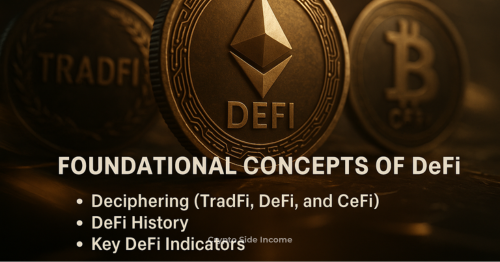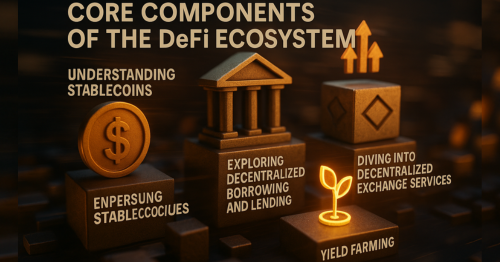
Foundational Concepts of DeFi
DeFi Deep Dive: As decentralized finance (DeFi) reshapes the global financial landscape, it’s crucial to grasp its foundational elements. To truly appreciate its disruptive potential, let’s break down what decentralized finance is and how it compares to traditional systems, explore its history, and examine the indicators that track its performance.

Deciphering TradFi, DeFi, and CeFi
Understanding DeFi begins with comparing it to two other financial models: Traditional Finance (TradFi) and Centralized Finance (CeFi).
- TradFi (Traditional Finance): This is the conventional financial system that has existed for centuries, comprising banks, insurance companies, stock exchanges, and governments. TradFi is centralized, permissioned, and heavily regulated. Transactions often require intermediaries, identity verification (KYC), and may take days to settle.
- CeFi (Centralized Finance): CeFi refers to platforms that offer crypto-based financial services but maintain a centralized structure. Examples include Binance, Coinbase, and BlockFi. While CeFi gives users exposure to crypto assets, it still requires them to trust the platform operators, who control custody, security, and governance.
- DeFi (Decentralized Finance): It offers a blockchain-powered alternative to traditional and centralized financial systems, enabling open and permissionless financial services. It eliminates intermediaries by using Smart Contracts, self-executing agreements coded on blockchains like Ethereum. DeFi protocols enable peer-to-peer lending, trading, saving, and investing, giving users full control over their assets. It’s permissionless, transparent, and typically open-source, allowing anyone with a crypto wallet to participate.
The key differentiator in DeFi is trustlessness, users don’t need to trust a company or middleman. Instead, they rely on code, community governance, and cryptographic transparency.
A Journey Through DeFi History
DeFi finds its origins in Bitcoin’s 2009 launch, which introduced a decentralized form of money designed to disrupt traditional, centralized financial control. However, Bitcoin’s use case was primarily limited to value transfer.
The real breakthrough came in 2015 with the launch of Ethereum, which introduced smart contracts, pieces of code that allow programmable financial logic. This breakthrough paved the way for the development of more advanced decentralized applications (dApps) across the blockchain ecosystem.
Major milestones in DeFi history
- 2017: It witnessed the launch of MakerDAO and its DAI stablecoin, the first truly decentralized lending protocol, ushering in a new era of decentralized borrowing and financial autonomy.
- 2018–2019: Projects like Compound and Uniswap gained traction, showing the viability of decentralized interest rates and token swapping.
- 2020: The “DeFi Summer” triggered exponential growth, with total value locked (TVL) skyrocketing. Yield farming and liquidity mining exploded in popularity.
- 2021–2022: Institutional adoption increased, Layer 2 solutions reduced gas fees, and the decentralized finance ecosystem expanded beyond Ethereum to include networks like Avalanche, Polygon, and Binance Smart Chain.
- 2023–2025: DeFi matured with enhanced security, more user-friendly interfaces, and cross-chain integrations, while also facing rising regulatory scrutiny.
DeFi has evolved beyond its experimental phase, emerging as a parallel financial ecosystem managing billions in assets and serving millions of users across the globe.
Understanding Key DeFi Indicators
To measure the growth and stability of DeFi, industry experts track several key indicators. These metrics offer valuable insights into platform performance, user adoption, and ecosystem health:
- Total Value Locked (TVL): Arguably the most cited metric, TVL reflects the total amount of crypto assets deposited in DeFi protocols. An increasing Total Value Locked (TVL) typically reflects growing user confidence, practical utility, and robust performance of a DeFi protocol.
- Daily Active Users (DAU): This metric measures the number of unique wallet addresses interacting with DeFi platforms each day. More users often indicate increasing adoption and real-world usage.
- Protocol Revenue: Generated from transaction fees and services, this metric helps evaluate the sustainability of a DeFi project. High protocol revenue means users are willing to pay for its utility.
- Liquidity and Volume: Healthy trading activity on decentralized exchanges (DEXs) is vital for efficient pricing and minimal slippage. Higher liquidity generally equates to better trading experiences.
- Token Supply Metrics: Understanding inflation, emission schedules, and circulating supply helps investors gauge token economics and long-term value.
Studying these indicators empowers both beginners and seasoned users to navigate the decentralized finance ecosystem wisely, making strategic choices on when and where to engage.
Core Components of the DeFi Ecosystem
DeFi, or Decentralized Finance, isn’t just a single platform or service, it’s a broad ecosystem of interconnected protocols that together provide a full suite of financial services on the blockchain. From stablecoins and decentralized lending to trading and yield farming, these components form the backbone of DeFi’s explosive growth and utility.

Understanding Stablecoins
Stablecoins, cryptocurrencies engineered to maintain a steady value, often tied to fiat currencies like the US dollar, are central to countless DeFi transactions. Stablecoins provide the essential liquidity and price stability that DeFi platforms rely on for trading, lending, and saving.
Types of Stablecoins:
- Fiat-collateralized: These stablecoins are backed by real-world assets held in reserve. Stablecoins, cryptocurrencies designed to hold a consistent value, typically pegged to fiat currencies like the US dollar, are central to many DeFi transactions, with popular examples including USDT (Tether) and USDC (USD Coin). They are widely used across DeFi platforms due to their perceived stability and high liquidity.
- Crypto-collateralized: Backed by other cryptocurrencies instead of fiat. DAI, created by MakerDAO, is the leading example. These require over-collateralization to protect against volatility.
- Algorithmic stablecoins: It use self-executing smart contracts and dynamic algorithms to balance supply and demand, aiming to maintain price stability without the need for collateral backing. However, they are high-risk, as demonstrated by the collapse of TerraUSD (UST).
Why Stablecoins Matter in DeFi:
- Enable price-stable trading pairs on DEXs.
- Serve as collateral in lending protocols.
- Facilitate cross-border payments without currency conversion.
- Allow hedging against crypto volatility while staying on-chain.
In essence, stablecoins are the “digital cash” of DeFi, foundational to virtually every decentralized financial activity.
Exploring Decentralized Borrowing and Lending
One of DeFi’s most transformative innovations is peer-to-peer borrowing and lending without banks or intermediaries. Platforms like Compound, Aave, and MakerDAO allow users to lend assets and earn interest or borrow by locking up collateral, all executed through smart contracts.
How It Works:
- Lenders deposit assets into a lending pool and earn yield (interest) in return.
- Borrowers lock up collateral (usually over 100% of the borrowed amount) and receive another asset in exchange.
- Interest rates in DeFi are fluid, automatically shifting in response to the changing supply and demand of individual assets.
Benefits of Decentralized Lending:
- No credit checks or third-party approval.
- Users can gain instant access to funds by leveraging their crypto holdings as collateral.
- Users can earn passive income by holding interest-bearing tokens such as cTokens from Compound or aTokens from Aave, which automatically accrue yield over time.
- Fully transparent interest rate models and smart contract rules.
However, borrowers face liquidation risks if their collateral value drops below a certain threshold. Users must monitor their positions carefully or use automated liquidation protection tools.
Diving Into Decentralized Exchange Services
A Decentralized Exchange (DEX) enables users to trade cryptocurrencies peer-to-peer directly from their own wallets, eliminating the need for a central authority. As one of the most prominent use cases in DeFi, DEXs offer greater control, privacy, and security in digital asset trading.
Key DEX Protocols:
- Uniswap: Pioneered the Automated Market Maker (AMM) model, allowing anyone to provide liquidity.
- SushiSwap: It is a community-led fork of Uniswap that enhances the DEX model by integrating yield farming features and rewarding users for providing liquidity.
- Curve Finance: It is a DeFi protocol tailored for seamless, low-slippage stablecoin trading, making it a go-to choice for efficient stable asset swaps.
- Balancer: Offers customizable liquidity pools with multiple tokens.
How DEXs Work:
Instead of using traditional order books, most DEXs use liquidity pools. These liquidity pools consist of token pairs, such as ETH/USDC, supplied by users, known as liquidity providers, who earn fees in return for facilitating trades. When a trade occurs, the smart contract automatically calculates the price based on the pool’s ratio.
DEX Advantages:
- No sign-up or KYC, just connect a wallet and trade.
- You retain full control over your assets at all times, without ever handing them over to a third party.
- Often lower fees than centralized platforms.
- Permissionless listings allow for rapid innovation.
However, DEXs may suffer from slippage and impermanent loss for liquidity providers, especially in volatile markets.
Yield Farming
Yield farming, also known as liquidity mining, refers to strategies that maximize returns on crypto holdings by deploying assets across multiple DeFi platforms.
What Is Yield Farming?
Users deposit their crypto assets into liquidity pools, lending protocols, or staking contracts. In return, they earn rewards, often a mix of interest, trading fees, and native governance tokens.
Popular Yield Farming Platforms:
- Yearn Finance: Automates the best farming strategies using “vaults.”
- PancakeSwap: BSC-based DEX offering high APYs on liquidity pools.
- Convex Finance: It is a DeFi platform designed to boost rewards for Curve liquidity providers by optimizing staking and yield strategies without requiring direct interaction with Curve’s governance.
- Frax and Curve: Often used together for farming stablecoins.
Why Yield Farming Is Popular:
- Offers significantly higher returns than traditional finance.
- Users can compound earnings by reinvesting rewards.
- Many platforms reward users with governance tokens that can be held or sold.
Risks of Yield Farming:
- Weaknesses in smart contracts can lead to security breaches, potentially causing users to lose their funds.
- Impermanent loss affects liquidity providers.
- High volatility of farming tokens can erode gains.
- Rug pulls or scams from unaudited projects.
Yield farming requires a good understanding of risk-reward dynamics. While lucrative, it’s best approached with caution, diversification, and due diligence.
Risks, Rewards, and the Road Ahead
The rise of Decentralized Finance (DeFi) has unlocked groundbreaking opportunities in finance, putting the power of money directly in users’ hands. Yet, as with any emerging technology, DeFi carries its own set of risks and challenges. Understanding the trade-offs and preparing accordingly is essential for anyone venturing into the decentralized frontier. In this section, we break down key risks like impermanent loss and slippage, explore the challenges DeFi must overcome, and offer tips to protect yourself on your DeFi journey.

3.1 Navigating Impermanent Loss and Slippage
While DeFi offers high yields and autonomy, it also introduces unique risks that are often misunderstood, particularly by new users. Two such risks are impermanent loss and slippage, both commonly encountered in liquidity provision and trading.
Impermanent Loss (IL):
Impermanent loss occurs when you provide two tokens to a liquidity pool (e.g., ETH and USDC) and their market prices change relative to each other. When this happens, the pool automatically rebalances the asset ratios through trading. This rebalancing can result in a lower value of your total holdings compared to simply holding the tokens individually.
- The term “impermanent” refers to the fact that the loss isn’t guaranteed. If the token prices return to their original ratio, the value may recover.
- However, if you withdraw your liquidity before this happens, the loss becomes permanent.
- In certain cases, elevated trading fees and earned rewards can fully compensate for, or even surpass, the effects of impermanent loss.
Slippage:
Slippage refers to the variance between the anticipated price of a trade and the actual price at which it is executed. Slippage refers to the variance between the anticipated price of a trade and the actual price at which it is executed. It’s especially noticeable when:
- Trading large amounts on low-liquidity pairs.
- Executing trades in volatile markets.
- Using AMM-based DEXs like Uniswap, where prices shift with every trade.
To manage slippage:
- Use stablecoin pairs with low volatility.
- You can adjust slippage tolerance settings directly within your wallet or DEX interface to manage trade execution risks.
- Stick to high-liquidity pools.
Understanding these risks is crucial for any investor considering liquidity provision or large trades in DeFi protocols.
3.2 Shaping DeFi’s Future and Confronting Challenges
As DeFi continues its rapid evolution, it faces both opportunities and hurdles that will define its place in the global financial system. While the potential is immense, the ecosystem must tackle multiple challenges to ensure long-term growth and stability.
Scalability and Network Congestion:
Ethereum, the backbone of many DeFi apps, has faced scalability issues due to high gas fees and slow transaction speeds during peak usage. The introduction of Ethereum 2.0 and Layer 2 solutions (like Optimism, Arbitrum, and zk-rollups) aims to solve this by improving throughput and reducing costs.
Regulatory Uncertainty:
Regulatory bodies around the world are placing growing focus on the DeFi sector as it continues to expand and mature. Key concerns include:
- Lack of KYC/AML compliance
- Securities violations (especially around governance tokens)
- User protection and liability
As regulations evolve, DeFi must find ways to stay compliant while preserving decentralization. Hybrid models with optional identity layers or regulated front ends may emerge as a compromise.
Security Risks and Protocol Exploits:
Smart contracts are only as safe as the code behind them. Even top-tier protocols have been affected by:
- Flash loan attacks
- Oracle manipulation
- Reentrancy bugs
Security audits, bug bounties, and open-source review help, but they don’t eliminate risk. Platforms are now moving toward formal verification and multi-layer defenses to enhance contract safety.
Interoperability and Fragmentation:
With DeFi operating across Ethereum, Solana, Avalanche, and other chains, cross-chain compatibility is becoming essential. Bridges and aggregators are helping unify liquidity, but bridge hacks (like the Ronin or Harmony incidents) show the risks involved.
3.3 Safeguarding Your DeFi Journey
With both high rewards and high risks, protecting yourself in DeFi requires strategy, research, and caution. Here’s how to approach your DeFi experience safely and successfully:
1. Use Trusted Wallets and Cold Storage:
- Connect to DeFi apps via secure wallets like MetaMask, Coinbase Wallet, or Trust Wallet.
- For long-term holdings, consider hardware wallets (e.g., Ledger or Trezor) to reduce online exposure.
2. Research Protocols Thoroughly:
- Check whether the platform has been audited by reputable firms (e.g., CertiK, Trail of Bits).
- Look for open-source code and active developer communities.
- Steer clear of projects that lack transparency or are led by anonymous teams, as they often pose higher risks for investors.
3. Start Small and Diversify:
- Test new platforms with small amounts of capital before committing.
- Don’t put all your funds in a single protocol or yield farm, diversify across different projects and strategies.
4. Monitor Your Positions:
- Use DeFi dashboards like Zapper, DeBank, or Yieldwatch to track yields, health ratios, and wallet performance.
- Set up notifications for liquidations or protocol updates.
5. Stay Updated:
- Follow official project channels (Twitter, Discord, Medium) for the latest announcements.
- Engage with communities on forums like Reddit or DeFiLlama Chat to learn from others.
Conclusion
DeFi is revolutionizing finance by offering open, transparent, and permissionless alternatives to traditional banking and centralized crypto services. From stablecoins and lending protocols to DEXs and yield farming, it empowers users with full control over their assets.
While DeFi brings immense opportunities, it also carries risks like impermanent loss, slippage, and smart contract vulnerabilities. Navigating this space safely requires education, due diligence, and smart risk management.
As DeFi continues to evolve, those who stay informed and cautious will be best positioned to benefit from its growing potential. The future of finance is decentralized. Are you ready to be part of it?
Frequently Asked Questions
What is DeFi and how does it work?
DeFi (Decentralized Finance) is a blockchain-based financial system that enables users to lend, borrow, trade, and earn interest without banks or intermediaries. It uses smart contracts for secure, automated transactions.
What are the main benefits of DeFi?
DeFi offers global access, full asset control, lower fees, faster transactions, and passive income opportunities like staking and yield farming, all without relying on centralized entities.
Is DeFi safe to use?
While DeFi is transparent and permissionless, it carries risks like smart contract bugs, impermanent loss, and platform hacks. Using audited protocols and secure wallets can improve safety.
What are stablecoins and why are they important in DeFi?
Stablecoins are cryptocurrencies pegged to fiat currencies like USD. They provide price stability, making them essential for trading, lending, and liquidity provision in the DeFi ecosystem.
What is yield farming in DeFi?
Yield farming involves depositing crypto into DeFi protocols to earn rewards, usually interest, fees, or tokens. It’s a popular but high-risk way to generate passive income.









